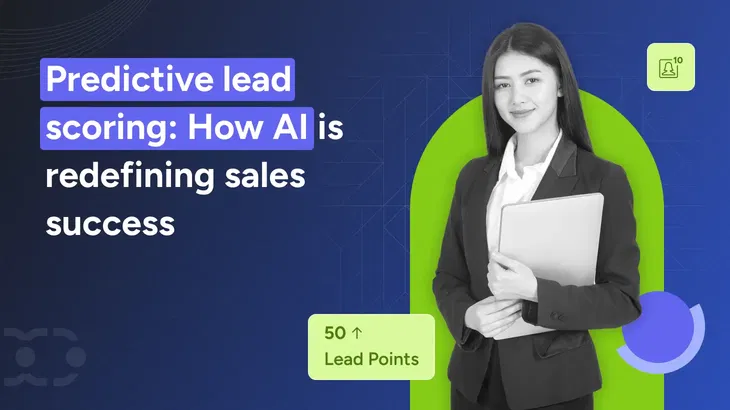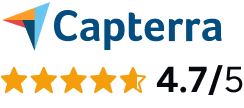Overwhelmed by too many leads and too little time? Or does your sales team waste hours chasing unqualified prospects?
A report revealed that 44% of sales reps are too busy to follow up on every lead, and poor lead quality drains time, resources, and opportunities.
Predictive lead scoring changes the game by prioritizing the leads most likely to convert, saving time, and boosting sales.
This guide will help you understand how to set up predictive lead scoring to streamline your sales process and drive conversions.
What is predictive lead scoring?
Predictive lead scoring uses advanced analytics and AI to identify leads with the highest likelihood of converting for your business.
Unlike traditional lead scoring, the predictive method is smarter and works with real data, not guesswork.
For example:
Manual: "A lead getting 10 points based on downloading an eBook."
Predictive: "AI spots that the lead downloaded a pricing guide, visited your website three times, and even browsed competitor reviews, assigning a higher score because they're likely ready to buy.
Here are the major differences between the manual and predictive lead scoring models:
| Aspect | Manual scoring | Predictive scoring |
| Data sources | Limited (e.g., job title, actions) | Extensive (behavioral, demographic, external) |
| Process | Manual, time-consuming | Automated, AI-driven |
| Accuracy | Subjective, prone to bias | Data-driven, high accuracy |
How does predictive lead scoring work?
Let's study how predictive scoring turns raw data into actionable insights:
- Data input: Collect diverse data points such as behavioral signals (e.g., website visits), demographics (e.g., company size), and historical patterns (e.g., purchase history).
- AI analysis: Use AI and machine learning algorithms to analyze the data and assign scores based on conversion likelihood.
- Prioritization: Focus on hot leads with the highest scores, ensuring your team can maximize sales conversion.
Predictive lead scoring processes ensure better quality predictions based on data-backed insights. Next, explore the key data types that fuel predictive scoring models.
What types of data should you consider for predictive lead scoring?
Predictive lead scoring uses diverse data, from contact details to behavioral insights, to paint a complete picture of each lead.
Here is how good and poor quality leads are identified with the predictive lead scoring system:
Let's study the key types of predictive lead-scoring data:
1. Demographics
Demographic data includes age, location, job title, industry, and company size. These insights help you narrow down leads that fit your ideal customer profile (ICP).
2. Behavioral signals
Behavioral data captures a lead's actions and engagement with your brand, such as website visits, email opens, content downloads, and webinar participation.
This reveals their level of interest and readiness to buy.
For instance, a lead spending time on your product comparison page and attending your webinars is likely more interested than someone who only downloaded a brochure.
3. Historical data
Historical data examines past customer behavior to identify patterns that signal conversion likelihood.
By analyzing how previous buyers interacted with your brand, you can predict similar outcomes for new leads.
For example, if previous buyers often interacted with your blog before purchasing, similar behavior in new leads could signal readiness to buy.
4. External data and AI augmentation
External data comes from third-party sources like the SaaS industry; the resources could be G2, LinkedIn, and TrustRadius.
It adds valuable context by capturing insights such as competitor comparisons, reviews, or recent job changes.
For instance, a lead browsing competitor reviews or recently taking on a decision-making role might indicate strong intent, increasing their score.
The predictive lead scoring algorithm uses this diverse data to rank leads, enabling your team to prioritize effectively.
7 Benefits of using predictive lead scoring
The predictive scoring method unites marketing and sales, enabling smarter strategies and greater efficiency. Here's how the plan is beneficial:
1. Improved lead prioritization
Predictive scoring saves time by automatically identifying interested leads. Businesses report a 30% increase in sales efficiency when prioritizing leads with predictive tools.
For instance, a SaaS company might prioritize users who attended multiple product demos and requested pricing information, as these actions signal strong buying intent.
2. Enhanced accuracy through data-driven insights
AI for predictive lead scoring eliminates guesswork and human error by analyzing large datasets. This ensures your sales team targets the right leads with precision.
Unlike traditional scoring methods that rely on manual entry and limited criteria, predictive scoring evaluates diverse factors like behavioral patterns and external data, providing more reliable results.
3. Faster sales cycles
Focusing on high-intent leads accelerates engagement, shortens sales cycles, and drives faster deal closures.
For instance, by targeting leads who've visited the pricing page multiple times, your reps can skip introductory conversations and dive straight into tailored solutions, cutting the sales cycle in half.
4. Stronger marketing and sales alignment
Predictive scoring provides a unified view of lead quality, improving collaboration between marketing and sales teams to drive better results.
Marketing can pass on highly qualified leads to sales, backed by detailed insights on their behavior and readiness to buy. This alignment ensures smoother handoffs and higher conversion rates.
5. Scalability for large datasets
Manual lead scoring struggles with large volumes of data. However, a company with thousands of monthly leads can use predictive scoring to rank and manage them efficiently, ensuring no high-potential opportunities are overlooked.
6. Increased revenue opportunities
It identifies upselling, cross-selling, and retention opportunities within your existing customer base, maximizing customer lifetime value.
For example, a predictive model might flag a current customer browsing advanced product features as a candidate for an upsell, enabling your team to act proactively.
7. Real-time adaptability
The most fruitful aspect of advanced models is that they continuously refine themselves based on new data, ensuring the scoring system remains relevant and aligned with evolving customer behaviors.
Moving on to understand how lead scoring impacts our overall customer journey touchpoints.
How does predictive lead scoring transform the customer journey?
Predictive lead scoring models reshape the customer journey by aligning marketing, sales, and experience with precision.
1. Targeted campaigns
Predictive lead scoring allows marketing teams to identify high-quality leads much earlier.
It analyzes behaviors like website visits, email interactions, and downloads, and the system pinpoints which prospects are most likely to engage.
This means campaigns can be highly targeted, focusing on the right audience instead of casting a wide net.
The result?
Personalized experiences that resonate with prospects and lead to better engagement.
For example, a lead researching your product can receive tailored email sequences highlighting benefits specific to their industry, which increases conversion rates significantly.
2. Sales precision
Predictive lead scoring highlights prospects with the highest probability of closing, allowing reps to focus their efforts on those truly ready to buy. This sharpens the sales process and eliminates inefficiencies.
For instance, a sales rep can prioritize following up with a lead who has visited the pricing page multiple times rather than one who downloaded a general brochure. This precision shortens the sales cycle and increases the likelihood of closing deals.
3. Enhanced customer experience
Instead of bombarding all leads with generic messages, your team can provide personalized communication tailored to each prospect's stage in the buying journey.
For example, a lead just starting to explore your product may receive educational content, while one nearing a purchase decision gets a special discount offer or a demo invitation.
This thoughtful approach builds trust, strengthens relationships, and ensures prospects feel valued throughout the journey.
Stop wasting time on low-value leads!
Salesmate CRM lets you filter, prioritize, and engage the leads that matter most—boost conversions with personalized, data-driven outreach.
Steps to implement predictive lead scoring effectively
Implementing predictive lead scoring requires a strategic approach and the right tools to ensure accuracy, alignment with business goals, and seamless execution.
Here's a step-by-step guide:
1. Define objectives
Start by setting clear, measurable goals that align with your sales and marketing strategies.
For this, the objective could be:
Increase lead-to-conversion rates by 20%.
Shorten the sales cycle by 15%.
Clear objectives help you track progress and measure the effectiveness of your scoring efforts.
2. Choose the right predictive lead-scoring software
Select software that integrates seamlessly with your CRM and offers features that enhance accuracy and usability.
Look for predictive lead-scoring solutions with:
- Automated data cleaning: Ensures reliable input for accurate scoring.
- Transparent scoring criteria: This helps teams understand how scores are calculated.
- Real-time insights: Keeps scoring aligned with changing customer behavior.
You can explore tools like Salesmate, HubSpot, or Salesforce Einstein for scalable and efficient lead-scoring solutions.
Planning to invest in the best solution? Here are the: 12 top lead-scoring tools you must check.
3. Prepare data
Identify and clean data sources like CRM records, website analytics, and email logs to ensure reliable scoring.
Here is a data-cleaning checklist for predictive lead scoring:
- Consolidate CRM records.
- Remove duplicates.
- Validate key data fields (e.g., email, job title)
Automated data-cleaning tools are used to save time and maintain consistency.
4. Train models
Use lead scoring predictive analytics to analyze historical data, identify conversion patterns, and train predictive algorithms for better lead prioritization.
For instance, you can prioritize leads frequently visiting pricing pages or engaging with webinars.
You can make custom lead scoring models within Salesmate as shown below:
Salesmate's custom lead scoring lets you create your scoring system based on over 60 triggers and actions.
It helps you identify and prioritize your most engaged leads so your sales team focuses on the ones that matter.
Explore more: 5 Most popular lead scoring models you must check!.
5. Integrate seamlessly
Embed the scoring tool into your workflows for easy access to insights. Ensure compatibility with your existing CRM and train teams for smooth adoption.
Here are some tips for implementing:
- Test integrations before rollout.
- Provide hands-on training for your sales and marketing teams to maximize efficiency.
6. Monitor and optimize
Regularly review scoring performance using dashboards and analytics. Refine your model based on evolving customer behaviors and market trends. Further, you can set monthly or quarterly audits to update scoring criteria and ensure alignment with business goals.
Grow faster and work smarter with Salesmate CRM
Streamline your sales, automate processes, and boost team productivity—all in one powerful platform.
Measuring the success of predictive lead scoring
Evaluate your advanced lead-scoring strategy by tracking key metrics and using analytics tools for actionable insights.
Here are some key metrics to focus on:
| Metric | What it measures | Why it matters |
| Lead-to-conversion ratio | Percentage of high priority leads converted into customers. | Indicates the effectiveness of lead prioritization. |
| Sales cycle length | Time taken to close deals. | Shorter cycles show improved efficiency. |
| ROI of scoring software | Revenue gains vs. cost of software. | Validates the investment in predictive scoring. |
| Lead score accuracy | Alignment of lead scores with outcomes. | Reflects the precision of the scoring model. |
Leverage the best predictive lead-scoring software with built-in dashboards to track these metrics in real time. These tools allow you to:
Analyze scoring performance at a glance.
Refine algorithms based on fresh data and changing market trends.
Identify areas for improvement and optimize your scoring strategy.
Challenges and limitations of predictive lead scoring
Predictive lead scoring offers immense benefits, but it comes with specific challenges that businesses need to address:
Predictive scoring relies heavily on clean, high-quality data. Incomplete or outdated information can lead to inaccurate scores, affecting lead prioritization.
Solution: Regularly clean and update your database to ensure data integrity.
Implementing advanced lead scoring requires expertise and time to configure and align models with existing systems.
Solution: Start with smaller datasets, use vendor support, and scale as you grow.
Skewed or incomplete data can introduce biases, leading to unfair or inaccurate lead evaluations.
Solution: Conduct regular audits and supplement internal data with external sources to balance predictions.
Insightful read: Automated lead scoring to auto-prioritize for success.
Wrap up
With AI in sales and marketing on the boom, technological advances are a demand of the hour.
Investing in predictive lead scoring can contribute to boosting sales conversions by identifying and prioritizing leads, replacing guesswork with AI-driven precision.
If you plan to transform your lead management strategy, explore tools offering seamless integration, actionable insights, and customizable scoring models.







Key Takeaways
Overwhelmed by too many leads and too little time? Or does your sales team waste hours chasing unqualified prospects?
A report revealed that 44% of sales reps are too busy to follow up on every lead, and poor lead quality drains time, resources, and opportunities.
Predictive lead scoring changes the game by prioritizing the leads most likely to convert, saving time, and boosting sales.
This guide will help you understand how to set up predictive lead scoring to streamline your sales process and drive conversions.
What is predictive lead scoring?
Predictive lead scoring uses advanced analytics and AI to identify leads with the highest likelihood of converting for your business.
Unlike traditional lead scoring, the predictive method is smarter and works with real data, not guesswork.
For example:
Manual: "A lead getting 10 points based on downloading an eBook."
Predictive: "AI spots that the lead downloaded a pricing guide, visited your website three times, and even browsed competitor reviews, assigning a higher score because they're likely ready to buy.
Here are the major differences between the manual and predictive lead scoring models:
How does predictive lead scoring work?
Let's study how predictive scoring turns raw data into actionable insights:
Predictive lead scoring processes ensure better quality predictions based on data-backed insights. Next, explore the key data types that fuel predictive scoring models.
What types of data should you consider for predictive lead scoring?
Predictive lead scoring uses diverse data, from contact details to behavioral insights, to paint a complete picture of each lead.
Here is how good and poor quality leads are identified with the predictive lead scoring system:
Let's study the key types of predictive lead-scoring data:
1. Demographics
Demographic data includes age, location, job title, industry, and company size. These insights help you narrow down leads that fit your ideal customer profile (ICP).
2. Behavioral signals
Behavioral data captures a lead's actions and engagement with your brand, such as website visits, email opens, content downloads, and webinar participation.
This reveals their level of interest and readiness to buy.
For instance, a lead spending time on your product comparison page and attending your webinars is likely more interested than someone who only downloaded a brochure.
3. Historical data
Historical data examines past customer behavior to identify patterns that signal conversion likelihood.
By analyzing how previous buyers interacted with your brand, you can predict similar outcomes for new leads.
For example, if previous buyers often interacted with your blog before purchasing, similar behavior in new leads could signal readiness to buy.
4. External data and AI augmentation
External data comes from third-party sources like the SaaS industry; the resources could be G2, LinkedIn, and TrustRadius.
It adds valuable context by capturing insights such as competitor comparisons, reviews, or recent job changes.
For instance, a lead browsing competitor reviews or recently taking on a decision-making role might indicate strong intent, increasing their score.
The predictive lead scoring algorithm uses this diverse data to rank leads, enabling your team to prioritize effectively.
7 Benefits of using predictive lead scoring
The predictive scoring method unites marketing and sales, enabling smarter strategies and greater efficiency. Here's how the plan is beneficial:
1. Improved lead prioritization
Predictive scoring saves time by automatically identifying interested leads. Businesses report a 30% increase in sales efficiency when prioritizing leads with predictive tools.
For instance, a SaaS company might prioritize users who attended multiple product demos and requested pricing information, as these actions signal strong buying intent.
2. Enhanced accuracy through data-driven insights
AI for predictive lead scoring eliminates guesswork and human error by analyzing large datasets. This ensures your sales team targets the right leads with precision.
Unlike traditional scoring methods that rely on manual entry and limited criteria, predictive scoring evaluates diverse factors like behavioral patterns and external data, providing more reliable results.
3. Faster sales cycles
Focusing on high-intent leads accelerates engagement, shortens sales cycles, and drives faster deal closures.
For instance, by targeting leads who've visited the pricing page multiple times, your reps can skip introductory conversations and dive straight into tailored solutions, cutting the sales cycle in half.
4. Stronger marketing and sales alignment
Predictive scoring provides a unified view of lead quality, improving collaboration between marketing and sales teams to drive better results.
Marketing can pass on highly qualified leads to sales, backed by detailed insights on their behavior and readiness to buy. This alignment ensures smoother handoffs and higher conversion rates.
5. Scalability for large datasets
Manual lead scoring struggles with large volumes of data. However, a company with thousands of monthly leads can use predictive scoring to rank and manage them efficiently, ensuring no high-potential opportunities are overlooked.
6. Increased revenue opportunities
It identifies upselling, cross-selling, and retention opportunities within your existing customer base, maximizing customer lifetime value.
For example, a predictive model might flag a current customer browsing advanced product features as a candidate for an upsell, enabling your team to act proactively.
7. Real-time adaptability
The most fruitful aspect of advanced models is that they continuously refine themselves based on new data, ensuring the scoring system remains relevant and aligned with evolving customer behaviors.
Moving on to understand how lead scoring impacts our overall customer journey touchpoints.
How does predictive lead scoring transform the customer journey?
Predictive lead scoring models reshape the customer journey by aligning marketing, sales, and experience with precision.
1. Targeted campaigns
Predictive lead scoring allows marketing teams to identify high-quality leads much earlier.
It analyzes behaviors like website visits, email interactions, and downloads, and the system pinpoints which prospects are most likely to engage.
This means campaigns can be highly targeted, focusing on the right audience instead of casting a wide net.
The result?
Personalized experiences that resonate with prospects and lead to better engagement.
For example, a lead researching your product can receive tailored email sequences highlighting benefits specific to their industry, which increases conversion rates significantly.
2. Sales precision
Predictive lead scoring highlights prospects with the highest probability of closing, allowing reps to focus their efforts on those truly ready to buy. This sharpens the sales process and eliminates inefficiencies.
For instance, a sales rep can prioritize following up with a lead who has visited the pricing page multiple times rather than one who downloaded a general brochure. This precision shortens the sales cycle and increases the likelihood of closing deals.
3. Enhanced customer experience
Instead of bombarding all leads with generic messages, your team can provide personalized communication tailored to each prospect's stage in the buying journey.
For example, a lead just starting to explore your product may receive educational content, while one nearing a purchase decision gets a special discount offer or a demo invitation.
This thoughtful approach builds trust, strengthens relationships, and ensures prospects feel valued throughout the journey.
Stop wasting time on low-value leads!
Salesmate CRM lets you filter, prioritize, and engage the leads that matter most—boost conversions with personalized, data-driven outreach.
Steps to implement predictive lead scoring effectively
Implementing predictive lead scoring requires a strategic approach and the right tools to ensure accuracy, alignment with business goals, and seamless execution.
Here's a step-by-step guide:
1. Define objectives
Start by setting clear, measurable goals that align with your sales and marketing strategies.
For this, the objective could be:
Increase lead-to-conversion rates by 20%.
Shorten the sales cycle by 15%.
Clear objectives help you track progress and measure the effectiveness of your scoring efforts.
2. Choose the right predictive lead-scoring software
Select software that integrates seamlessly with your CRM and offers features that enhance accuracy and usability.
Look for predictive lead-scoring solutions with:
You can explore tools like Salesmate, HubSpot, or Salesforce Einstein for scalable and efficient lead-scoring solutions.
3. Prepare data
Identify and clean data sources like CRM records, website analytics, and email logs to ensure reliable scoring.
Here is a data-cleaning checklist for predictive lead scoring:
Automated data-cleaning tools are used to save time and maintain consistency.
4. Train models
Use lead scoring predictive analytics to analyze historical data, identify conversion patterns, and train predictive algorithms for better lead prioritization.
For instance, you can prioritize leads frequently visiting pricing pages or engaging with webinars.
You can make custom lead scoring models within Salesmate as shown below:
Salesmate's custom lead scoring lets you create your scoring system based on over 60 triggers and actions.
It helps you identify and prioritize your most engaged leads so your sales team focuses on the ones that matter.
5. Integrate seamlessly
Embed the scoring tool into your workflows for easy access to insights. Ensure compatibility with your existing CRM and train teams for smooth adoption.
Here are some tips for implementing:
6. Monitor and optimize
Regularly review scoring performance using dashboards and analytics. Refine your model based on evolving customer behaviors and market trends. Further, you can set monthly or quarterly audits to update scoring criteria and ensure alignment with business goals.
Grow faster and work smarter with Salesmate CRM
Streamline your sales, automate processes, and boost team productivity—all in one powerful platform.
Measuring the success of predictive lead scoring
Evaluate your advanced lead-scoring strategy by tracking key metrics and using analytics tools for actionable insights.
Here are some key metrics to focus on:
Leverage the best predictive lead-scoring software with built-in dashboards to track these metrics in real time. These tools allow you to:
Analyze scoring performance at a glance.
Refine algorithms based on fresh data and changing market trends.
Identify areas for improvement and optimize your scoring strategy.
Challenges and limitations of predictive lead scoring
Predictive lead scoring offers immense benefits, but it comes with specific challenges that businesses need to address:
Predictive scoring relies heavily on clean, high-quality data. Incomplete or outdated information can lead to inaccurate scores, affecting lead prioritization.
Solution: Regularly clean and update your database to ensure data integrity.
Implementing advanced lead scoring requires expertise and time to configure and align models with existing systems.
Solution: Start with smaller datasets, use vendor support, and scale as you grow.
Skewed or incomplete data can introduce biases, leading to unfair or inaccurate lead evaluations.
Solution: Conduct regular audits and supplement internal data with external sources to balance predictions.
Wrap up
With AI in sales and marketing on the boom, technological advances are a demand of the hour.
Investing in predictive lead scoring can contribute to boosting sales conversions by identifying and prioritizing leads, replacing guesswork with AI-driven precision.
If you plan to transform your lead management strategy, explore tools offering seamless integration, actionable insights, and customizable scoring models.
Dhara Thakkar
SEO SpecialistDhara Thakkar is a seasoned marketer at Salesmate. She thrives on trying new organic strategies to improve traffic & conversions, and has in-depth knowledge on how search works. When she's not working, you will find her travelling or binge watching F.R.I.E.N.D.S